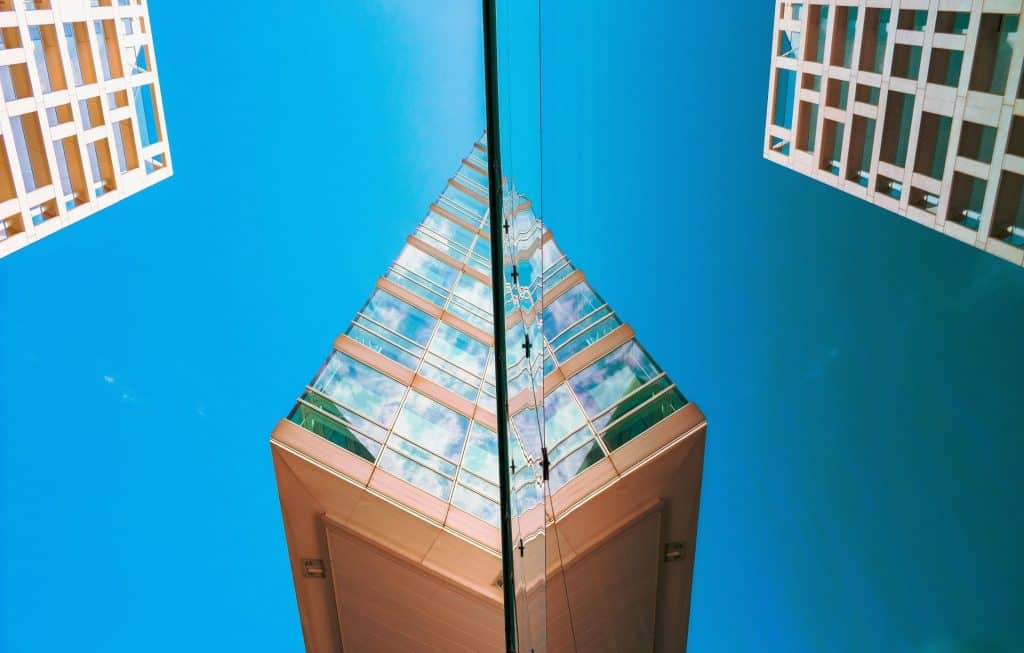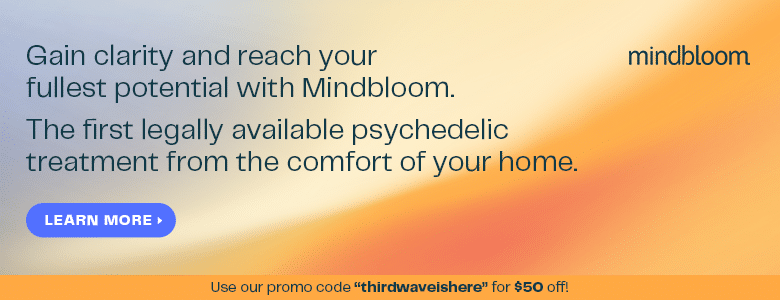In part 1 of this review of Mindbloom, I provided a little background on Mindbloom’s treatment model, why Third Wave chose to partner with them, and the details of my first experience with Mindbloom.
For those interested, you can save $50 on your Mindbloom experience with the code thirdwaveishere.
And now for part 2, where we dive into the last three sessions I underwent and share perspectives on overall benefits and outcomes.
The Mindbloom Experience
For the second Mindbloom experience, I dropped another 300 mg of ketamine down the hatch, lay back on the Shakti mat, vibed with the Apollo Neuro, and went deep into the subconscious, guided by the incredible Mindbloom soundtrack.
Popped out of it, mulled over the insights, got some rest, and woke up in the morning for a full-on journaling session to integrate what came up.
And the truth? Nothing so profoundly revelatory, or insightful, or mind-blowing arose during the experiences, at least no single insight that significantly shaped the trajectory of my day-to-day decision-making.
This same vibe and feeling was true of experience three and four with the Mindbloom protocol. Basically, I would consume the lozenge, swishing it around the mouth for 10 minutes, and then swallow everything. Soon after, a feeling of light-headedness would start to envelop my sense of being, which signaled that it was time to put the headphones and eye-mask on, lie down, and surrender to the experience.
In total darkness, I moved deeper into myself through the undulating Soundcloud soundtrack. When thoughts pertaining to stress, or anxiety, or not-being-enough would arise, I could feel them slip away. Ideas or feelings that were normally suppressed also suddenly had space to arise without resistance, so they could be consciously processed, observed, and released.
And some of that magical sparkle that I had become so familiar with from the classic psychedelics began to creep back into my existence, replacing negative thought-loops with internal messages of empowerment, belief, and creativity.
Mundane, day-to-day worries around financials, the shame around consistent cannabis use, and the worry about simply “not being enough” vanished, leaving a quiet, voluptuous spaciousness, free from the neuroticism of everyday existence.
Admittedly, ketamine lozenges don’t pack the same punch as five grams of dried psilocybin mushrooms or two cups of yage. But as a classic dissociative, ketamine does has enough impact to provide a respite from the neuroticism of everyday life, even if it isn’t quite as dramatic as natural plant medicine when done in a ceremonial context.
Which, for many beginners to psychedelic medicine, is a perfect starting point. What we always teach at Third Wave, particularly around microdosing, is the importance of “start low, go slow”. Ketamine lozenges ease you into the shallow end of working with the subconscious and unconscious, but don’t overwhelm you. It’s a beautiful middle-ground that allows for processing the undercurrents of life without shaking up the snow globe in a crazy, chaotic mess.

Calibrating the Mindbloom Experience
It’s also worth noting that I deviated from the prescribed Mindbloom protocol in three key ways:
- Instead of spitting out the ketamine lozenges, I swallowed them, which meant higher intensity and a longer-lasting experience. Because swallowing extends the half-life, there is more time to work with the subconscious mind. I do not recommend psychedelic beginners taking this route.
- Mindbloom recommends undergoing four experiences within one month for optimal outcomes. I did my first two experiences over two weeks in late December, early January, and my second two experiences over two weeks in late March. That meant I had two smaller windows rather than one long window of ketamine use. I recommend doing all four in a condensed period for optimal results for those interested in this experience.
- Mindbloom provides eyeshades, journals, soundtracks, and guides. While I used every one of these for my experience, I added a few accouterments to amplify the overall experience, namely the Apollo Neuro, the Shakti Mat, and a few albums from favorite artists.
These deviations felt aligned with my deeper intention and intuition. Because of 10+ years of experience with psychedelic medicine, I felt comfortable calibrating the experience.
If you’re an experienced psychonaut and have considered Mindbloom, it’s possible to play around with the overall protocol to fit your specific needs. If, however, you’re a newbie, we recommend following the Mindbloom instructions to a T as it will ensure the container created is highly sound for your first significant therapeutic psychedelic experiences.
What were the benefits of ketamine therapy?
My core intention for the Mindbloom treatment was to reduce general anxiety as a way to minimize frequent cannabis use. I also wanted to reflect on how to create better boundaries so as to not experience anxiety as often.
While the Mindbloom experience created separation between my thoughts and sense of self, the experiences weren’t significant enough to alter the deep-seated stories leading to anxiety and consistent cannabis use. Throughout the Mindbloom experience, I smoked less cannabis but did not eliminate it.
Further, the treatment coincided with a particularly stressful time for Third Wave as a business, meaning it was tricky to fully let go and surrender.
That’s why set and setting remains so important for impactful psychedelic use. Because Mindbloom is an at-home telemedicine experience, there is no separation between the experience itself and the banality of everyday life. One bleeds into the other.
Had I experienced ketamine within a retreat setting, with plenty of spaciousness to reconsider certain behaviors, the overall trajectory would likely have been much more successful.
And this is why psychedelics, when used as a sacrament or within a proper context, have always been separate from everyday life. That’s why in Ancient Greece, the top thinkers and leaders were brought out to the fields of Eleusis for a once-in-a-lifetime experience. That’s why, with the psilocybin retreat center I co-founded, Synthesis, we chose to build it around a transformative, out-of-the-ordinary experience in the beautiful countryside of the Netherlands.
While there is significant benefit to Mindbloom’s experience for many, it will never be as transformative as a retreat or clinical setting because it is so integrated within everyday life. While a high percentage of folks will likely notice and observe short-term benefits, it may not have the level of gravitas built into it to significantly alter the trajectory of millions of lives.
Which is totally okay, because you can’t let perfect be the enemy of good. Mindbloom has built a treatment care model to provide millions of people with access to psychedelic medicine within a healing framework—and the importance of this can’t be understated. In the wake of the global pandemic, anxiety remains at an all-time high. Countless people are feeling trapped in an endless loop of unrelenting stress, and Mindbloom’s therapy offers a window of relief.

A Sacred Set and Setting
By creating a sacramental setting around your Mindbloom journeys, it may be possible to experience real healing. As with so many psychedelic experiences, it comes down to set and setting. At-home ketamine therapy gives you the leeway to create an environment conducive to your mental wellbeing. Perhaps that means taking time off work for the day before and after your journey to simply take care of yourself. Maybe it means renting a small cabin or AirBNB to shift your ordinary reality and create a safe space without distractions. Thanks to the accessibility of Mindbloom’s treatment, these options—and countless others—are now suddenly viable.
All that said, there is a dark side that also needs to be highlighted: the risk of turning the psychedelic drug into a watered-down experience to which people must keep coming back for the relief, insight, or love we so yearn for.
Austin, Texas, has a phrase: “Let’s Keep Austin Weird.” I say the same for psychedelic medicine: Let’s keep it weird. Let’s keep it sacred. Let’s keep it outside the boundaries of everyday life. Only by making it separate can psychedelic medicine help humanity fulfill its interconnected future. But until we get there, I firmly believe Mindbloom is filling a critical role in reducing the stigma associated with psychedelic modalities and helping people tap into the potential to move past their daily struggles.








I’m currently doing a medical protocol of at-home ketamine injections for chronic pain/complex trauma, after previously experiencing IVs in a clinical setting.
I greatly prefer being at home for my dives; as my subconscious truly feels safe to fully enter dissociation here in my cozy bedroom with my loving spouse and pets nearby, instead of in a strange setting. I’m able to have more productive treatments (in concert with remote psychotherapy).
But I greatly enjoyed reading your viewpoint, it’s so interesting how individual psychedelic experiences are. I believe both types of settings are needed to appropriately accommodate patients.
Thank you so much for sharing Aimee. You’re absolutely right that experiences vary so greatly from person to person, and medicine to medicine.
Ketamine has been very helpful to me and my community and i have been able to guide people looking to source or buy ketamine off-label with my online platform ketaeurope.com. I have learnt a lot about ketamine therapy from mindbloom and thirdwave and it has inspired to help others and give them a platform where they can order ketamine online.